Sir John Monash, Personal Files Book 14, 6 October - 30 November 1916, Part 2
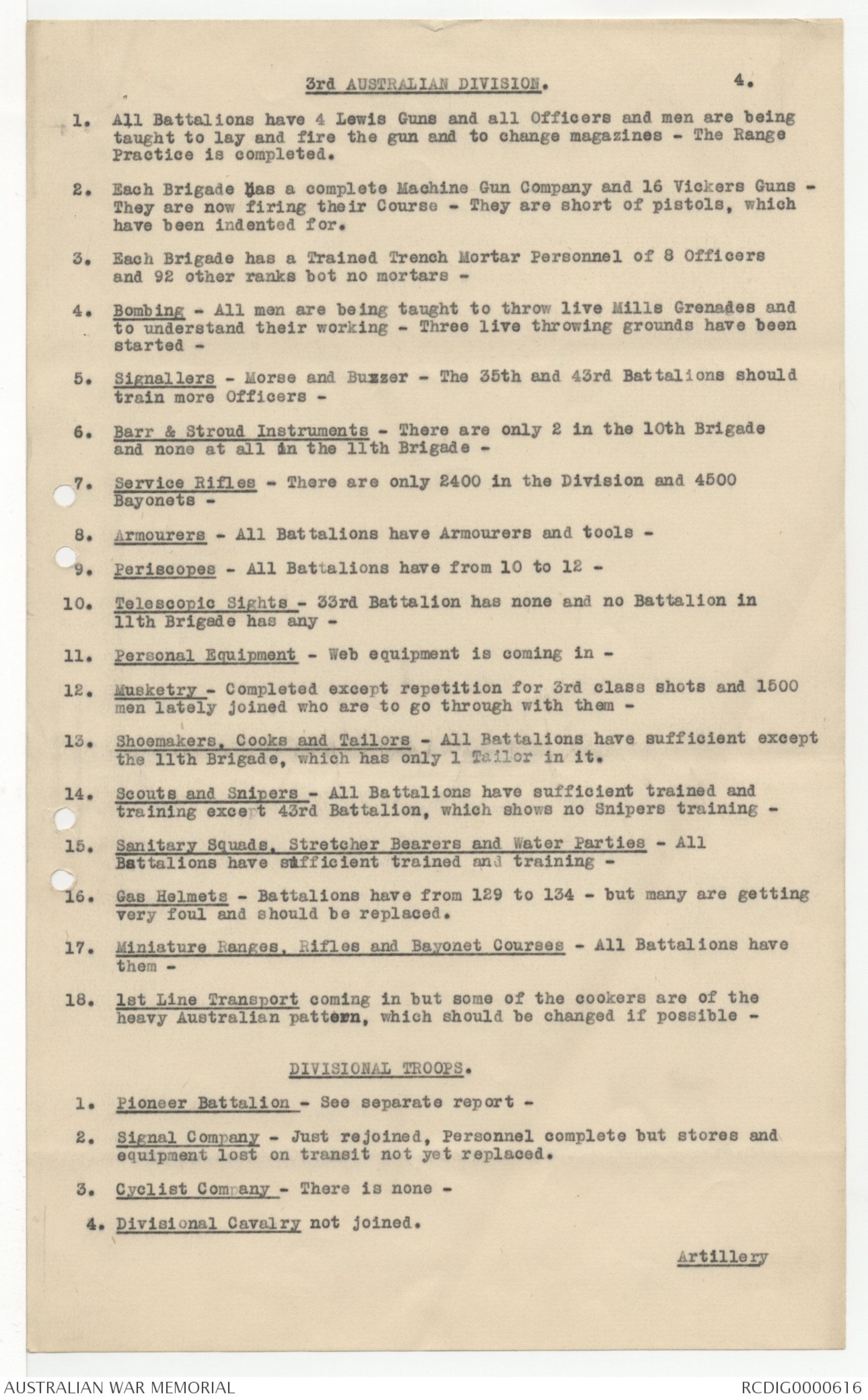
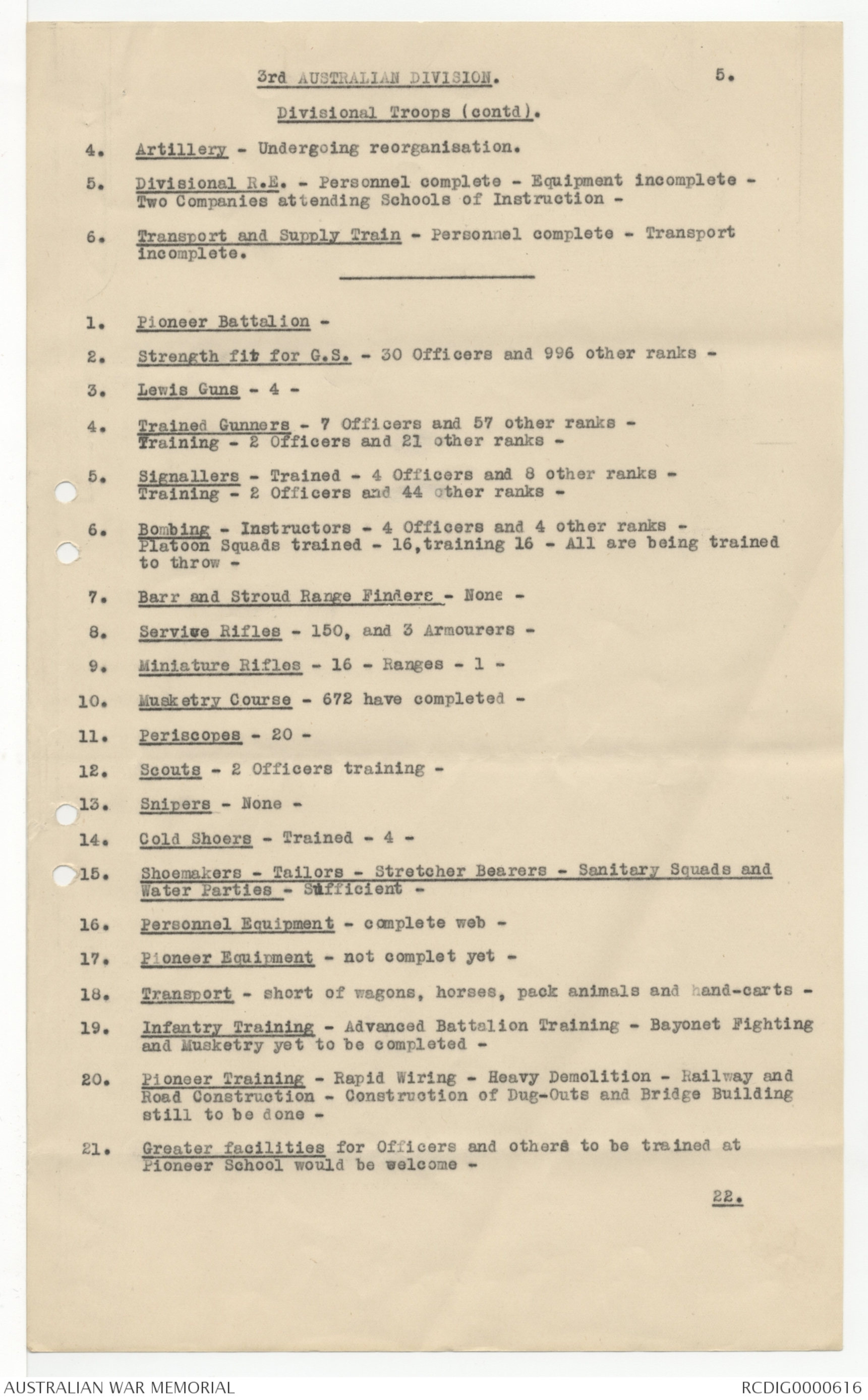
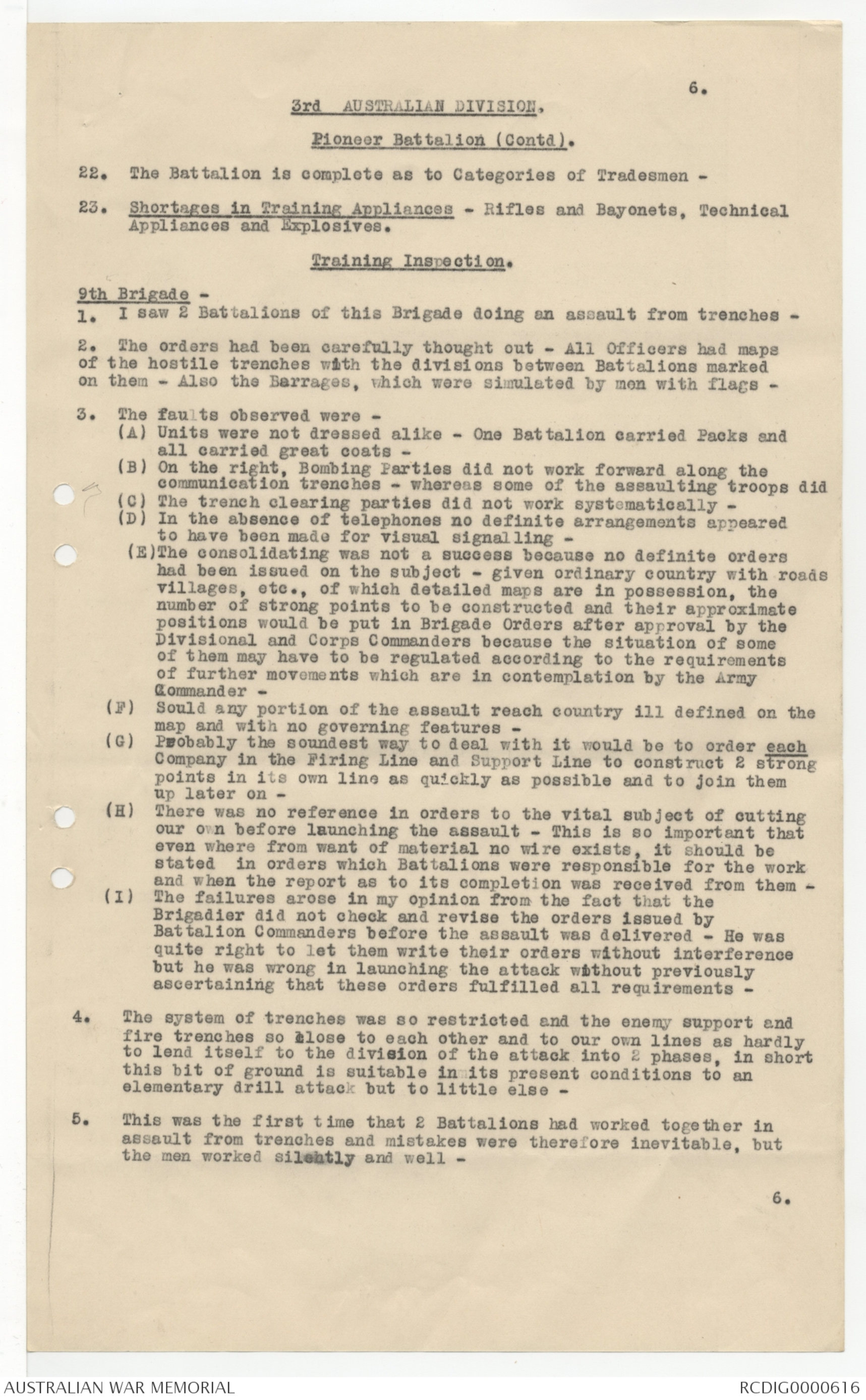
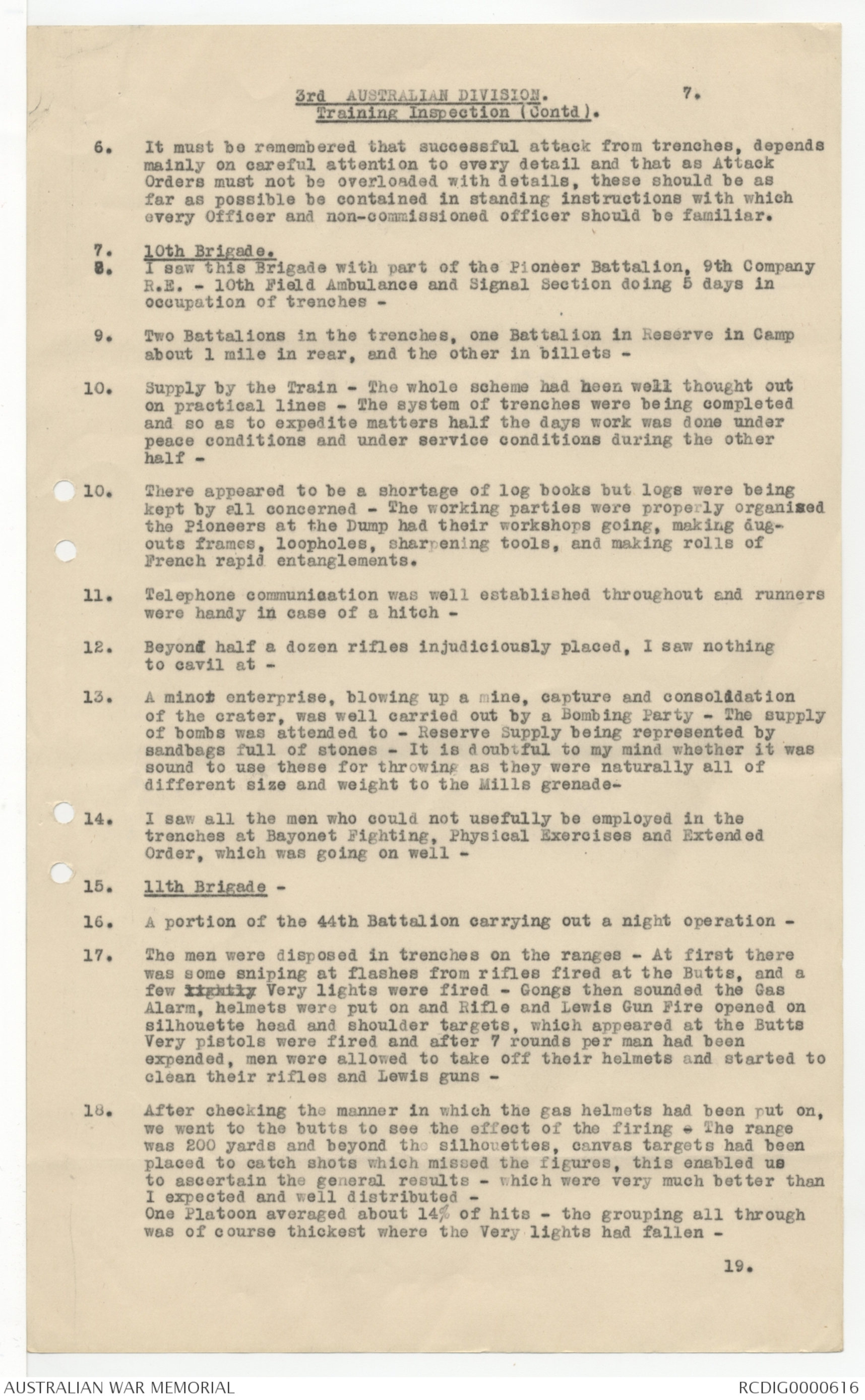
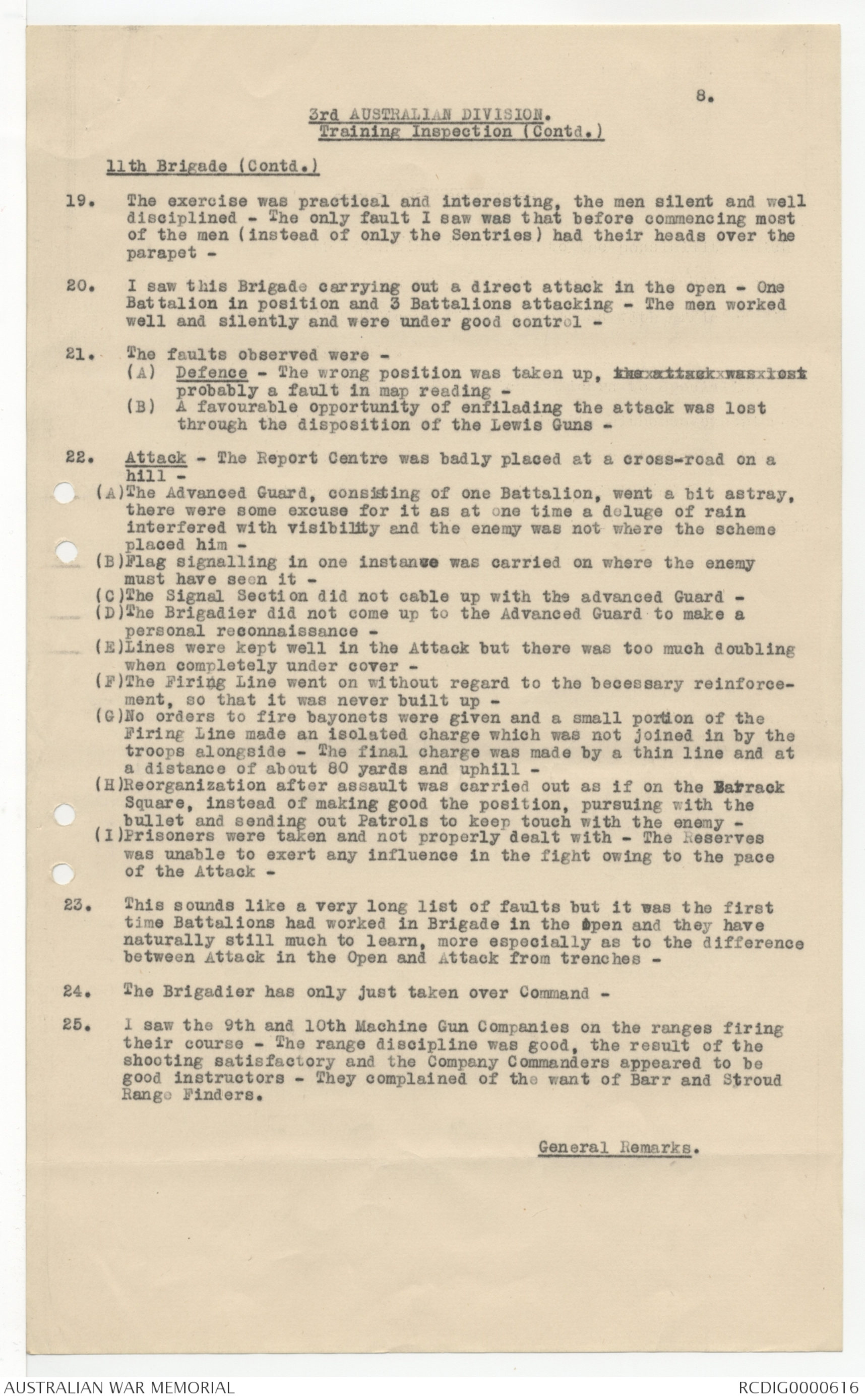
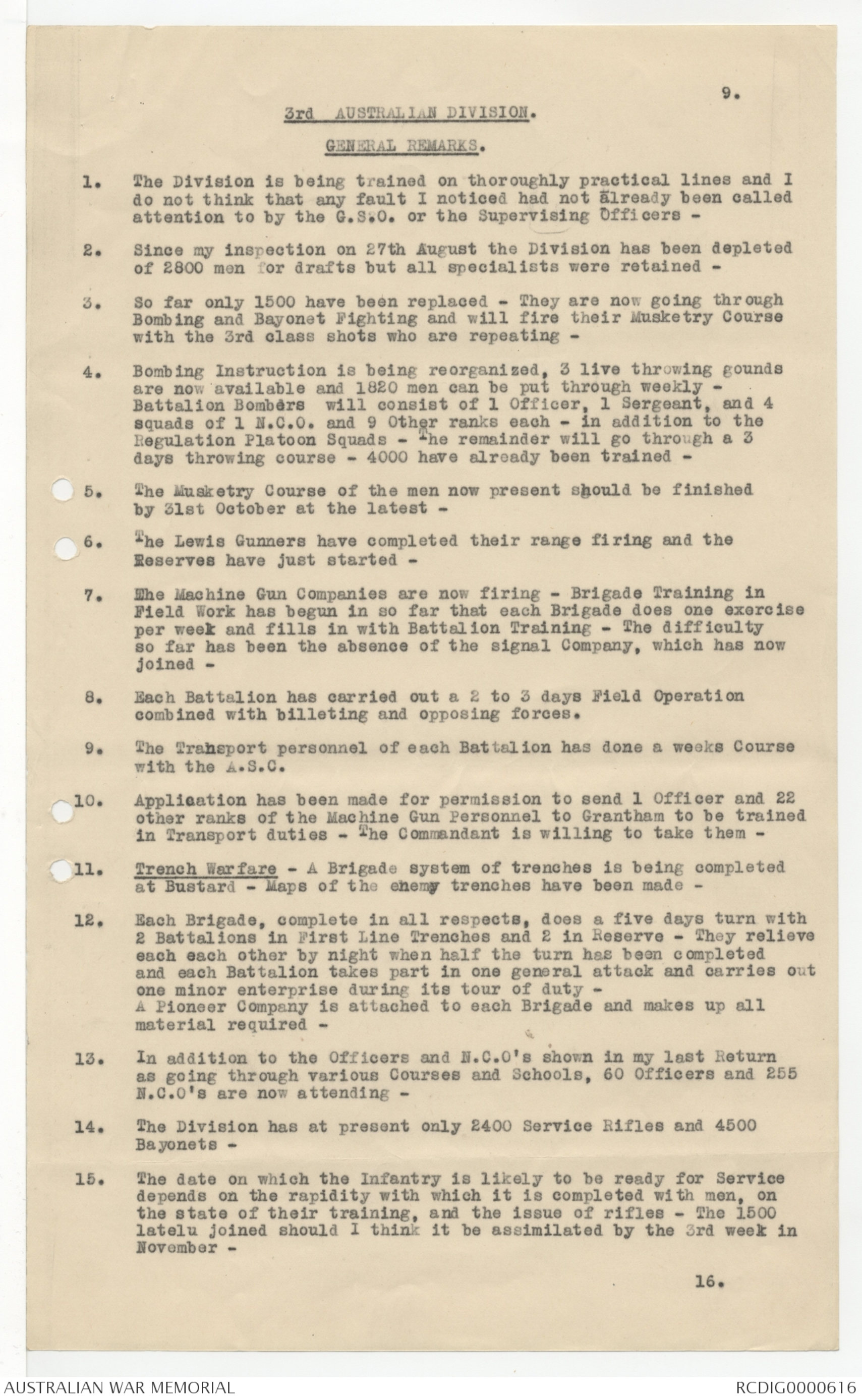
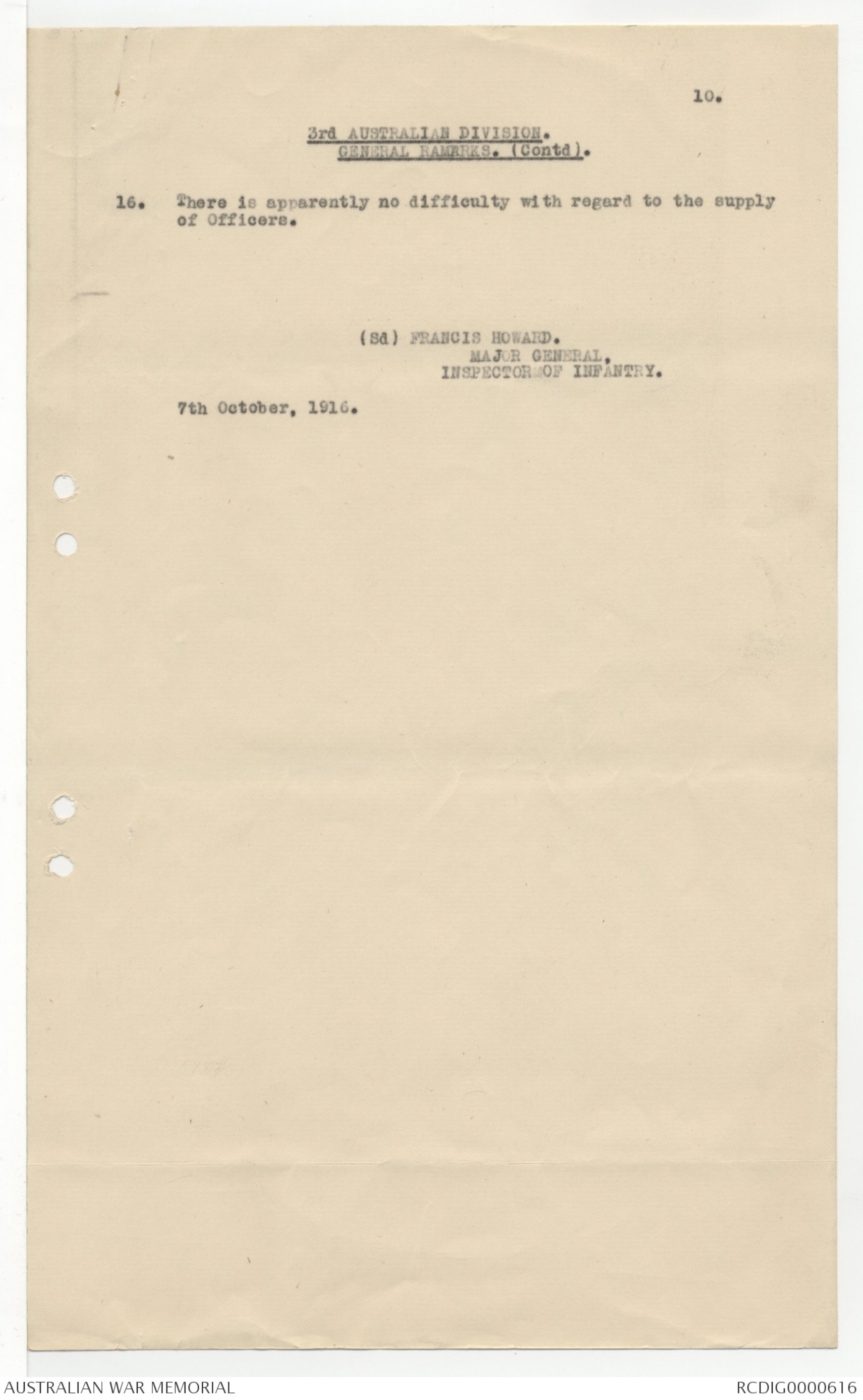
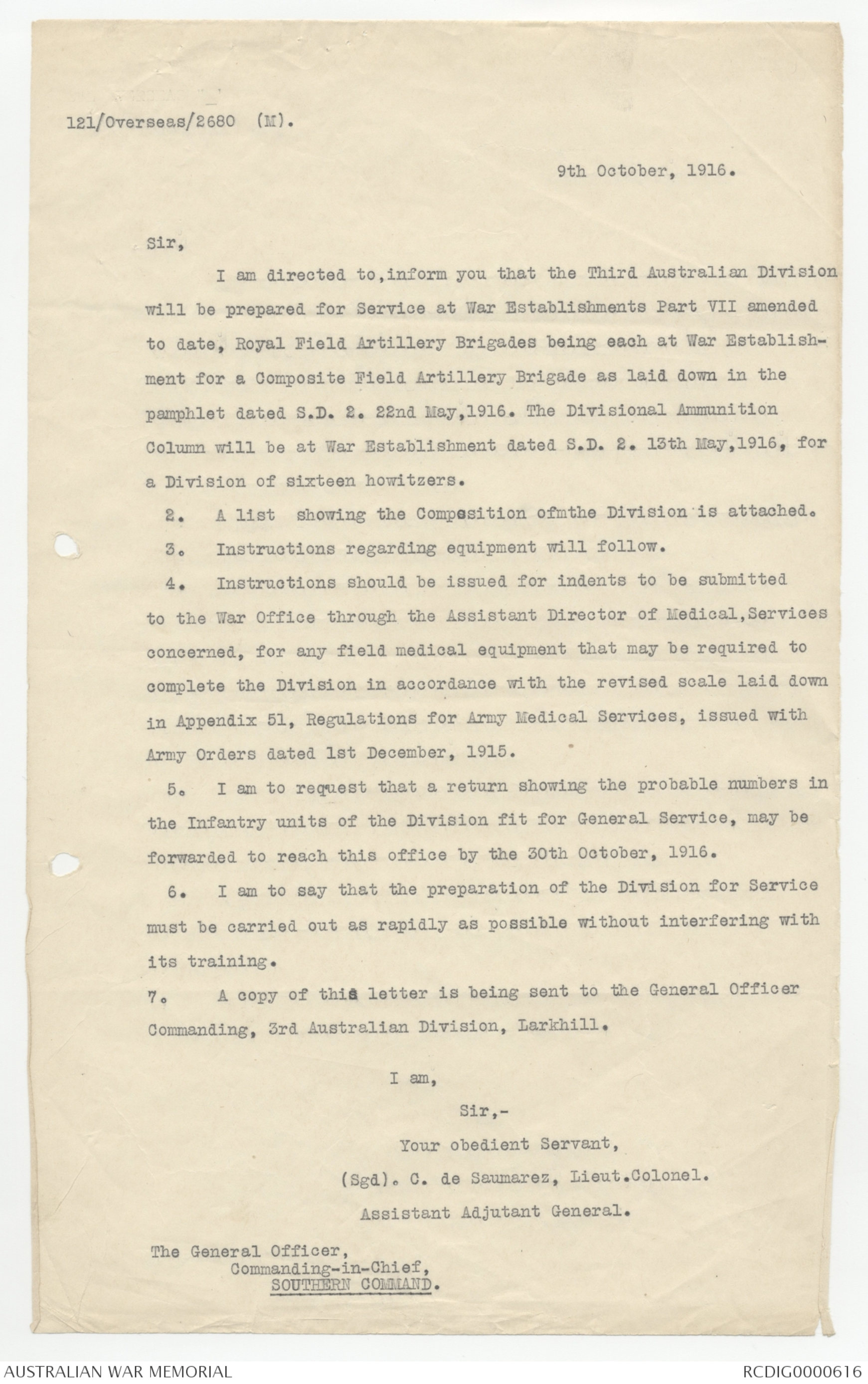
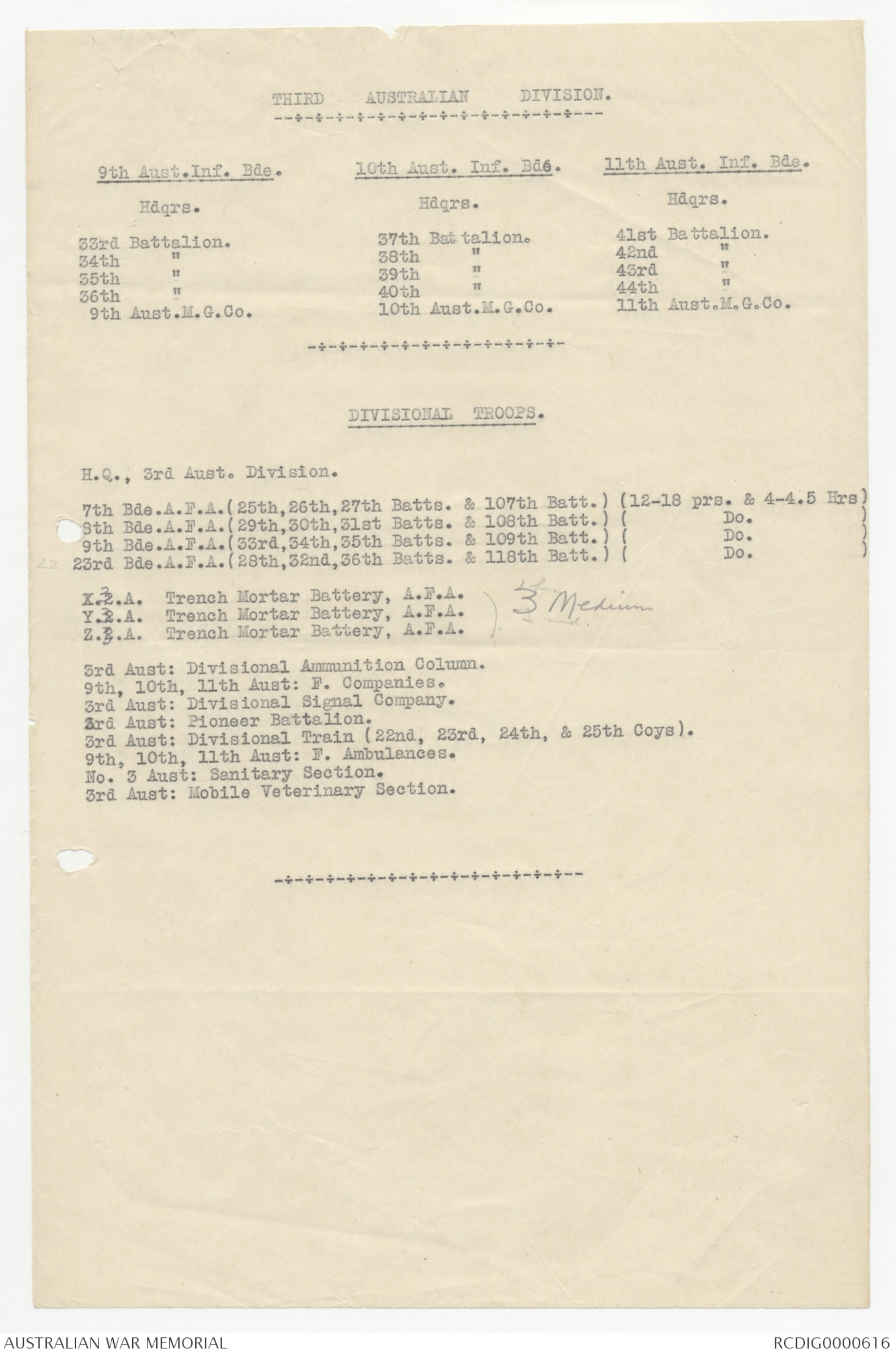
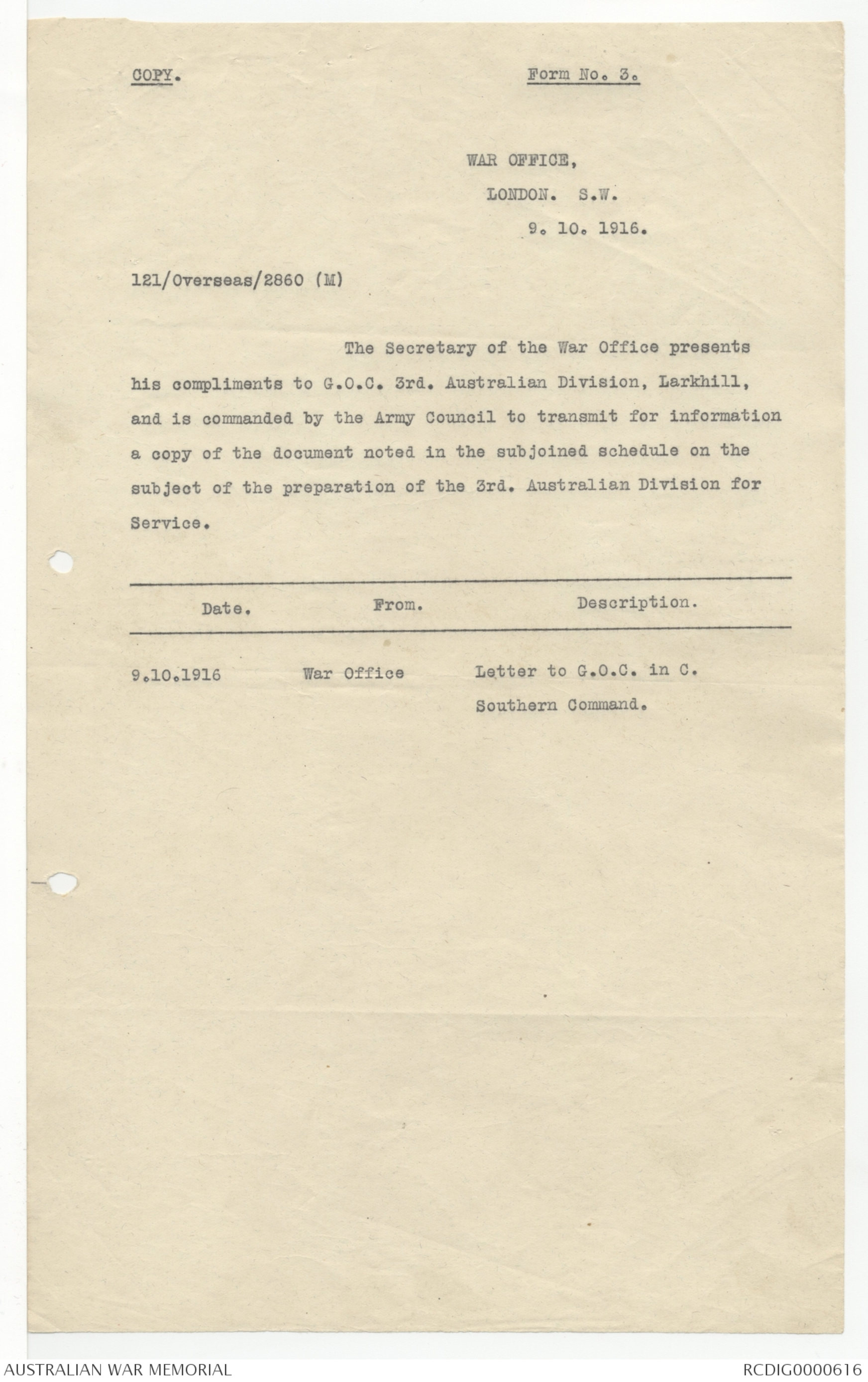
3rd AUSTRALIAN DIVISION. 4.
- All Battalions have 4 Lewis Guns and all Officers and men are being
taught to lay and fire the gun and to change magazines- The Range
Practice is completed.
2. Each Brigade has a complete Machine Gun Company and 16 Vickers Guns -
They are now firing their Course- They are short of pistols, which have been indented for.
3. Each Brigade has a Trained Trench Mortar Personnel of 8 Officers
and 92 other ranks bot no mortars -
4. Bombing - All men are being taught to throw live Mills Grenades and
to understand their working - Three live throwing grounds have been
started -
5. Signallers - Morse and Buzzer - The 35th and 43rd Battalions should
train more Officers -
6. Barr & Stroud Instruments - There are only 2 in the 10th Brigade
and none at all in the 11th Brigade.
7. Service Rifles- There are only 2400 in the Division and 4500
Bayonets -
8. Armourers - All Battalions have Armourers and tools -
9. Periscopes - All Battalions have from 10 to 12 -
10. Telescopic Sights - 33rd Battalion has none and no Battalion in
11th Brigade has any -
11. Personal Equipment - Web equipment is coming in -
12. Musketry - Completed except repetition for 3rd class shots and 1500
men lately joined who are to go through with them -
13. Shoemakers, Cooks and Tailors - All Battalions have sufficient except the 11th Brigade, which has only 1 Tailor in it.
14. Scouts and Snipers - All Battalions have sufficient trained and
training except 43rd Battalion, which shows no Snipers training -
15. Sanitary Squads, Stretcher Bearers and Water Parties - All
Battalions have sufficient trained and training -
16. Gas Helmets - Battalions have from 129 to 134 - but many are getting
very foul and should be replaced.
17. Miniature Ranges, Rifles and Bayonet Courses - All Battalions have
them -
18. 1st Line Transport coming in but some of the cookers are of the
heavy Australian pattern, which should be changed if possible -
DIVISIONAL TROOPS.
- Pioneer Battalion - See separate report -
2. Signal Company - Just rejoined, Personnel complete but stores and
equipment lost on transit not yet replaced.
3. Cyclist Company - There is none -
4. Divisional Cavalry not joined.
Artillery
3rd AUSTRALIAN DIVISION. 5.
Divisional Troops (contd).
4. Artillery - Undergoing reorganisation.
5. Divisional R.E. - Personnel complete - Equipment incomplete -
Two Companies attending Schools of Instruction -
6. Transport and Supply Train - Personnel complete - Transport
incomplete.
-------------------------------------------------------
- Pioneer Battalion -
- Strength fit for G.S. - 30 Officers and 996 other ranks -
3. Lewis Guns - 4 -
4. Trained Gunners - 7 Officers and 57 other ranks -
Training - 2 Officers and 21 other ranks -
5. Signallers -Trained - 4 Officers and 8 other ranks -
Training - 2 Officers and 44 other ranks -
6. Bombing - Instructors - 4 Officers and 4 other ranks -
Platoon Squads trained - 16, training 16 - All are being trained
to throw -
7. Barr and Stroud Range Finders - None -
8. Service Rifles - 150, and 3 Armourers -
9. Miniature Rifles - 16 - Ranges - 1 -
10. Musketry Course - 672 have completed -
11. Periscopes - 20 -
12. Scouts - 2 Officers training -
13. Snipers - None -
14. Cold Shoers - Trained - 4 -
15. Shoemakers - Tailors - Stretcher Bearers - Sanitary Squads and
Water Parties - Sufficient -
16. Personnel Equipment - complete web -
17. Pioneer Equipment - not complet yet -
18. Transport - short of wagons, horses, pack animals and hand-carts -
19. Infantry Training - Advanced Battalion Training - Bayonet Fighting
and Musketry yet to be completed -
20. Pioneer Training - Rapid Wiring - Heavy Demolition - Railway and
Road Construction - Construction of Dug-Outs and Bridge Building
still to be done -
21. Greater facilities for Officers and others to be trained at
Pioneer School would be welcome -
22.
3rd AUSTRALIAN DIVISION. 6.
Pioneer Battalion (Contd).
22. The Battalion is complete as to Categories of Tradesmen -
23. Shortages in Training Appliances - Rifles and Bayonets, Technical
Appliances and Explosives.
Training Inspection.
9th Brigade -
- I saw 2 Battalions of this Brigade doing an assault from trenches -
2. The orders had been carefully thought out - All Officers had maps
of the hostile trenches with the divisions between Battalions marked
on them - Also the Barrages, which were simulated by men with flags
3. The faults observed were -
(A) Units were not dressed alike - One Battalion carried Packs and
all carried great coats -
(B) On the right, Bombing Parties did not work forward along the
communication trenches - whereas some of the assaulting troops did
(C) The trench clearing parties did not work systematically -
(D) In the absence of telephones no definite arrangements appeared
to have been made for visual signalling -
(E) The consolidating was not a success because no definite orders
had been issued on the subject - given ordinary country with roads
villages, etc., of which detailed maps are in possession, the
number of strong points to be constructed and their approximate
positions would be put in Brigade Orders after approval by the
Divisional and Corps Commanders because the situation of some
of them may have to be regulated according to the requirements
of further movements which are in contemplation by the Army
Commander -
(F) Should any portion of the assault reach country ill defined on the
map and with no governing features -
(G) Probably the soundest way to deal with it would be to order each
Company in the Firing Line and Support Line to construct 2 strong
points in its own line as quickly as possible and to join them
up later on -
(H) There was no reference in orders to the vital subject of cutting
our own before launching the assault - This is so important that
even where from want of material no wire exists, it should be
stated in orders which Battalions were responsible for the work
and when the report as to its completion was received from them -
(I) The failures arose in my opinion from the fact that the
Brigadier did not check and revise the orders issued by
Battalion Commanders before the assault was delivered - He was
quite right to let them write their orders without interference
but he was wrong in launching the attack without previously
ascertaining that these orders fulfilled all requirements -
4. The system of trenches was so restricted and the enemy support and
fire trenches so close to each other and to our own lines as hardly
to lend itself to the division of the attack into 2 phases, in short
this bit of ground is suitable in its present conditions to an
elementary drill attack but to little else -
5. This was the first time that 2 Battalions had worked together in
assault from trenches and mistakes were therefore inevitable, but
the men worked silently and well -
6.
3rd AUSTRALIAN DIVISION. 7.
Training Inspection (Contd).
6. It must be remembered that successful attack from trenches, depends mainly on careful attention to every detail and that as Attack
Orders must not be overloaded with details, these should be as
far as possible be contained in standing instructions with which
every Officer and non-commissioned officer should be familiar.
7. 10th Brigade.
8. I saw this Brigade with part of the Pioneer Battalion, 9th Company
R.E. - 10th Field Ambulance and Signal Section doing 5 days in
occupation of trenches -
9. Two Battalions in the trenches, one Battalion in Reserve in Camp
about 1 mile in rear, and the other in billets -
10. Supply by the Train - The whole scheme had been well thought out
on practical lines - The system of trenches were being completed
and so as to expedite matters half the days work was done under
peace conditions and under service conditions during the other
half -
10. There appeared to be a shortage of log books but logs were being
kept by all concerned - The working parties were properly organized
the Pioneers at the Dump had their workshops going, making dugouts
frames, loopholes, sharpening tools, and making rolls of
French rapid entanglements.
11. Telephone communication was well established throughout and runners were handy in case of a hitch -
12. Beyond half a dozen rifles injudiciously placed, I saw nothing
to cavil at -
13. A minor enterprise, blowing up a mine, capture and consolidation
of the crater, was well carried out by a Bombing Party - The supply
of bombs was attended to - Reserve Supply being represented by
sandbags full of stones - It is doubtful to my mind whether it was
sound to use these for throwing as they were naturally all of
different size and weight to the Mills grenade -
14. I saw all the men who could not usefully be employed in the
trenches at Bayonet Fighting, Physical Exercises and Extended
Order, which was going on well -
15. 11th Brigade -
16. A portion of the 44th Battalion carrying out a night operation -
17. The men were disposed in trenches on the ranges - At first there
was some sniping at flashes from rifles fired at the Butts, and a
few lightly Very lights were fired - Gongs then sounded the Gas
Alarm, helmets were put on and Rifle and Lewis Gun Fire opened on
silhouette head and shoulder targets, which appeared at the Butts
Very pistols were fired and after 7 rounds per man had been
expended, men were allowed to take off their helmets and started to
clean their rifles and Lewis guns -
18. After checking the manner in which the gas helmets had been put on, we went to the butts to see the effect of the firing - The range
was 200 yards and beyond the silhouettes, canvas targets had been
placed to catch shots which missed the figures, this enabled us
to ascertain the general results - which were very much better than
I expected and well distributed -
One Platoon averaged about 14% of hits - the grouping all through
was of course thickest where the Very lights had fallen -
19.
3rd AUSTRALIAN DIVISION. 8.
Training Inspection(Contd.)
11th Brigade (Contd.)
19. The exercise was practical and interesting, the men silent and well
disciplined - The only fault I saw was that before commencing most
of the men (instead of only the Sentries) had their heads over the
parapet -
20. I saw this Brigade carrying out a direct attack in the open - One
Battalion in position and 3 Battalions attacking - The men worked
well and silently and were under good control -
21. The faults observed were-
(A) Defence - The wrong position was taken up, the attack was lost
probably a fault in map reading -
(B) A favourable opportunity of enfilading the attack was lost
through the disposition of the Lewis Guns -
22. Attack - The REport Centre was badly placed at a cross-road on a
hill -
(A) The Advanced Guard, consisting of one Battalion, went a bit astray,
there were some excuse for it as at one time a deluge of rain
interfered with visibility and the enemy was not where the scheme
placed him-
(B) Flag signalling in one instance was carried on where the enemy
must have seen it -
(C) The Signal Section did not cable up with the advanced Guard -
(D) The Brigadier did not come up to the Advanced Guard to make a
personal reconnaissance -
(E) Lines were kept well in the Attack but there was too much doubling
when completely under cover -
(F) The Firing Line went on without regard to the necessary reinforce-
ment, so that it was never built up -
(G) No orders to fire bayonets were given and a small portion of the
Firing Line made an isolated charge which was not joined in by the
troops alongside - The final charge was made by a thin line and at
a distance of about 80 yards and uphill -
(H) Reorganisation after assault was carried out as if on the Barrack
Square, instead of making good the position, pursuing with the
bullet and sending out Patrols to keep touch with the enemy-
(I) Prisoners were taken and not properly dealt with - The Reserves
was unable to exert any influence in the fight owing to the pace
of the Attack -
23. This sounds like a very long list of faults but it was the first
time Battalions had worked in Brigade in the open and they have
naturally still much to learn, more especially as to the difference
between Attack in the Open and Attack from trenches -
24. The Brigadier has only just taken over Command -
25. I saw the 9th and 10th Machine Gun Companies on the ranges firing
their course - The range discipline was good, the result of the
shooting satisfactory and the Company Commanders appeared to be
good instructors - They complained of the want of Barr and Stroud
Range Finders.
Genral Remarks.
3rd AUSTRALIAN DIVISION. 9.
GENERAL REMARKS.
-
The Division is being trained on thoroughly practical lines and I
do not think that any fault I noticed had not already been called
attention to by the G.S.O. or the Supervising Officers -
-
Since my inspection on 27th August the Division has been depleted
of 2800 men for drafts but all specialists were retained -
-
So far only 1500 have been replaced - They are now going through
Bombing and Bayonet Fighting and will fire their Musketry Course
with the 3rd class shots who are repeating -
-
Bombing Instruction is being reorganized, 3 live throwing grounds
are now available and 1820 men can be put through weekly -
Battalion Bombers will consist of 1 Officer, 1 Sergeant, and 4
squads of 1 N.C.O. and 9 Other ranks each - in addition to the
Regulation Platoon Squads - The remainder will go through a 3
days throwing course - 4000 have already been trained -
-
The Musketry Course of the men now present should be finished
by 31st October at the latest -
-
The Lewis Gunners have completed their range firing and the
Reserves have just started -
-
The Machine Gun Companies are now firing - Brigade Training in
Field Work has begun in so far that each Brigade does one exercise
per week and fills in with Battalion Training - The difficulty
so far has been the absence of the signal Company, which has now
joined -
-
Each Battalion has carried out a 2 to 3 days Field Operation
combined with billeting and opposing forces.
-
The Transport personnel of each Battalion has done a weeks Course
with the A.S.C.
-
Application has been made for permission to send 1 Officer and 22
other ranks of the Machine Gun Personnel to Grantham to be trained
in Transport duties - The Commandant is willing to take them -
-
Trench Warfare - A Brigade system of trenches is being completed
at Bustard - Maps of the enemy trenches have been made -
-
Each Brigade, complete in all respects, does a five days turn with
2 Battalions in First Line Trenches and 2 in Reserve - They relieve
each other by night when half the turn has been completed
and each Battalion takes part in one general attack and carries out
one minor enterprise during its tour of duty -
A Pioneer Company is attached to each Brigade and makes up all
material required -
-
In addition to the Officers and N.C.O's shown in my last Return
as going through various Courses and Schools, 60 Officers and 255
N.C.O's are now attending -
-
The Division has at present only 2400 Service Rifles and 4500
Bayonets -
-
The date on which the Infantry is likely to be ready for Service
depends on the rapidity with which it is completed with men, on
the state of their training, and the issue of rifles - The 1500
latelu joined should I think be assimilated by the 3rd week in
November -
16.
3rd AUSTRALIAN DIVISION. 10.
GENERAL REMARKS. (Contd).
16. There is apparently no difficulty with regard to the supply
of Officers.
(Sd) FRANCIS HOWARD.
MAJOR GENERAL.
INSPECTOR OF INFANTRY.
7th October, 1916.
121/Overseas/2680 (M).
9th October, 1916.
Sir,
I am directed to, inform you that the Third Australian Division
will be prepared for Service at War Establishments Part VII amended
to date, Royal Field Artillery Brigades being each at War Establish-
ment for a Composite Field Artillery Brigade as laid down in the
pamphlet dated S.D. 2. 22nd May, 1916. The Divisional Ammunition
Column will be at War Establishment dated S.D. 2. 13th May, 1916, for
a Division of sixteen howitzers.
2. A list showing the Composition of the Division is attached.
3. Instructions regarding equipment will follow.
4. Instructions should be issued for indents to be submitted
to the War Office through the Assistant Director of Medical, Services
concerned, for any field medical equipment that may be required to
complete the Division in accordance with the revised scale laid down
in Appendix 51, Regulations for Army Medical Services, issued with
Army Orders dated 1st December, 1915.
5. I am to request that a return showing the probable numbers in
the Infantry units of the Division fit for General Service, may be
forwarded to reach this office by the 30th October, 1916.
6. I am to say that the preparation of the Division for Service
must be carried out as rapidly as possible without interfering with
its training.
7. A copy of this letter is being sent to the General Officer
Commanding, 3rd Australian Division, Larkhill.
I am,
Sir,-
Your obedient Servant,
(Sgd). C. de Saumarez, Lieut.Colonel.
Assistant Adjutant General.
The General Officer,
Commanding-in-Chief,
SOUTHERN COMMAND.
THIRD AUSTRALIAN DIVISION.
9th Aust.Inf. Bde. 10th Aust. Inf. Bde. 11th Aust. Inf. Bde.
Hdqrs. Hdqrs. Hdqrs.
33rd Battalion. 37th Battalion. 41st Battalion.
34th " 38th " 42nd "
35th " 39th " 43rd "
36th " 40th " 44th "
9th Aust. M.G.Co. 10th Aust. M.G.Co. 11th Aust.M.G.Co.
-----------------------------------------------------------------
DIVISIONAL TROOPS.
H.Q., 3rd Aust. Division.
7th Bde.A.F.A.(25th, 26th, 27th Batts. & 107th Batt.) (12-18 prs. & 4-4.5Hrs)
8th Bde.A.F.A.(29th, 30th, 31st Batts. & 108th Batt.) ( Do. )
9th Bde.A.F.A.(33rd, 34th, 35th Batts. & 109th Batt.) ( Do. )
23rd Bde.A.F.A.(28th, 32nd, 36th Batts. & 118th Batt.) ( Do. )
X.23.A. Trench Mortar Battery, A.F.A.
Y.23.A. Trench Mortar Battery, A.F.A.
Z.23.A. Trench Mortar Battery, A.F.A. 3 Medium
3rd Aust: Divisional Ammunition Column.
9th, 10th, 11th Aust: F. Companies.
3rd Aust: Divisional Signal Company.
3rd Aust: Pioneer Battalion.
3rd Aust: Divisional Train (22nd, 23rd, 24th, & 25th Coys).
9th, 10th, 11th Aust: F. Ambulances.
No.3 Aust: Sanitary Section.
3rd Aust: Mobile Veterinary Section.
-------------------------------------------------
COPY. Form No. 3.
WAR OFFICE
LONDON. S.W.
9.10.1916.
121/Overseas/2860 (M)
The Secretary of the War Office presents
his compliments to G.O.C. 3rd. Australian Division, Larkhill,
and is commanded by the Army Council to transmit for information
a copy of the document noted in the subjoined schedule on the
subject of the preparation of the 3rd. Australian Division for
Service.
| Date. | From. | Description. |
| 9.10.1916 | War Office |
Letter to G.O.C. in C. Southern Command. |
 Sam scott
Sam scottThis transcription item is now locked to you for editing. To release the lock either Save your changes or Cancel.
This lock will be automatically released after 60 minutes of inactivity.